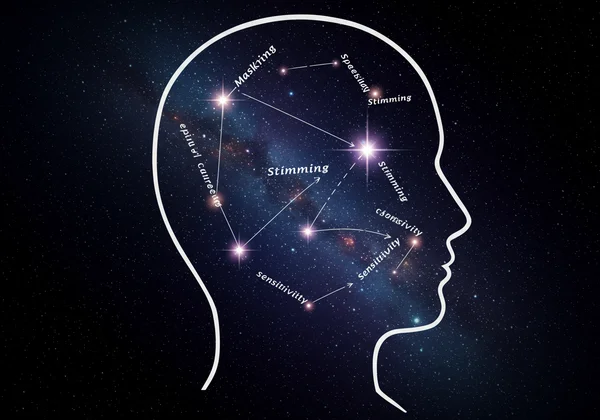Autistic Masking & Stimming: A Guide Before Your Autistic Test
Have you ever felt like you're playing a character in social situations, carefully mimicking others just to fit in? Or do you find yourself engaging in repetitive movements or sounds that help you focus or calm down when you feel overwhelmed? These common, yet often misunderstood, experiences are known as autistic masking and stimming. For many people on a journey of self-discovery, understanding these concepts is a profound first step. This guide demystifies these core concepts—including masking, stimming, and scripting—to help you find clarity and validation in your own path of self-exploration.
These behaviors are not just random quirks; they are deeply tied to how a neurodivergent brain interacts with the world. By exploring them, you open a door to understanding yourself more deeply and compassionately.
What Is Autistic Masking (Neurodivergent Masking)?
Autistic masking, also called neurodivergent masking or camouflaging, is the conscious or subconscious suppression of natural autistic traits to appear more "neurotypical." It's a social survival strategy developed to navigate a world that often misunderstands or stigmatizes neurodivergent behavior. Think of it as wearing a social costume, one that can be incredibly convincing but requires immense energy to maintain.

Masking isn't about deception; it's about protection. It’s an attempt to connect with others, secure employment, or simply avoid negative attention and judgment. While it can be a useful tool in certain situations, its long-term use comes at a significant personal cost. Many individuals, especially women and those diagnosed later in life, become so adept at masking that their underlying traits go unnoticed for years, even by themselves.
Why Do Autistic People Mask?
The motivations behind masking are complex and deeply human. At its core, it stems from a desire for acceptance and safety. An autistic person might mask to avoid being bullied or ostracized for their natural communication style or stims. In professional settings, masking can feel necessary to meet unspoken social expectations and advance in a career.
For many, it begins in childhood as a way to make friends or please adults. They observe their peers, study social interactions like a script, and practice in the mirror. This effort to blend in is a direct response to social pressure, both real and perceived. The ultimate goal is to minimize friction and navigate social landscapes that can feel confusing and unwelcoming.
Common Examples of Masking in Daily Life
Masking can manifest in countless ways, often becoming so ingrained that the person doing it barely notices the effort. Recognizing these behaviors can be a lightbulb moment for many.
Here are some common examples:
- Forcing or Faking Eye Contact: Maintaining eye contact can be intensely uncomfortable or overwhelming for many autistic people. Forcing it during conversations is a classic masking technique.
- Scripting Conversations: Mentally rehearsing conversations, complete with potential responses and branching dialogue, is a way to prepare for social interactions and reduce anxiety.
- Suppressing Stims: Consciously holding back natural self-stimulatory behaviors like hand-flapping, rocking, or humming, especially in public or professional settings.
- Mimicking Social Cues: Intentionally copying the body language, tone of voice, and facial expressions of others to appear engaged and "normal."
- Hiding Special Interests: Downplaying or avoiding talk about intense, passionate interests for fear of being seen as obsessive or weird.
The Hidden Cost: Why Masking Is So Exhausting
While masking can serve a purpose, the long-term toll is immense. Continuously performing a neurotypical persona is mentally and emotionally draining, often leading to a state known as autistic burnout. This is a severe form of exhaustion that can impact all areas of life, causing a loss of skills, increased sensory sensitivity, and profound fatigue.

Furthermore, chronic masking can lead to a weakened sense of self. When you spend your life pretending to be someone else, it can become difficult to know who you truly are underneath the mask. This can contribute to anxiety, depression, and a persistent feeling of being an imposter in your own life. Recognizing the exhaustion you feel may not be a personal failing but a direct result of the effort of masking can be incredibly validating.
What Is Stimming (Self-Stimulatory Behavior)?
Stimming, short for self-stimulatory behavior, refers to repetitive actions or sounds that autistic individuals use to regulate their senses, emotions, and thoughts. Far from being a meaningless or negative habit, stimming is a functional and often essential coping mechanism. It is a natural part of the human experience—neurotypical people do it too (e.g., tapping a pen, jiggling a leg)—but for autistic people, it is often more pronounced and serves a more critical regulatory purpose.

Instead of viewing stimming as something to be stopped, it is more helpful to see it as a form of personal expression and a tool for self-regulation. It is the body's way of managing an environment that can be overwhelming or, at times, underwhelming.
The Purpose of Stimming: Regulation and Expression
Stimming serves a wide variety of vital functions. It is not just one thing but a versatile tool for navigating the world. Key purposes include:
- Sensory Regulation: It can help manage sensory overload by providing a predictable, focused sensory input that blocks out overwhelming external stimuli. Conversely, it can provide needed input when an environment is under-stimulating.
- Emotional Management: Stimming can be a way to self-soothe during times of stress, anxiety, or sadness. It can also be an outward expression of intense joy and excitement.
- Improving Focus: Repetitive motion can help improve concentration by filtering out distractions, allowing the individual to focus on a specific task or thought.
Types of Stims: Beyond Hand-Flapping
The stereotype of stimming is often limited to hand-flapping, but the reality is far more diverse. Stims can engage any of the senses and look very different from person to person. Understanding this diversity can help you identify these behaviors in yourself or others.
- Visual: Staring at lights, tracing lines with the eyes, repetitive blinking.
- Auditory: Humming, repeating words or phrases (echolalia), making clicking sounds.
- Tactile: Rubbing soft fabrics, tapping fingers, skin picking, clenching fists.
- Vestibular: Rocking back and forth, spinning, pacing.
- Olfactory and Gustatory: Sniffing objects, chewing on non-food items like pen caps or sleeves.
Is Stimming a Negative Trait?
There is a common misconception that stimming is inherently negative or something that needs to be "fixed." This view is outdated and harmful. Stimming is a natural and healthy coping mechanism. It is a form of communication that says, "I am processing," "I am happy," or "I am overwhelmed."
The only time a stim should be addressed is if it causes physical harm (e.g., severe head-banging) or significantly impedes a person's ability to engage in life. In such cases, the goal is not to eliminate the stim but to find a safer, alternative stim that serves the same regulatory purpose. For the vast majority of stims, the most supportive action is acceptance.
Connecting These Behaviors to Autistic Traits
Masking and stimming are not isolated behaviors; they are windows into the underlying neurology of autism. They are directly connected to the core autistic experience, particularly in the areas of social communication and sensory processing. Masking is often a response to navigating social challenges, while stimming is a tool for managing sensory sensitivities.
Recognizing these two behaviors in yourself is a significant step. It often leads to the question: what other patterns might be present? Understanding how these pieces fit together is key to forming a complete picture of your unique neurotype.
How Masking and Stimming Fit into the Bigger Picture
Think of autistic traits as a constellation. Masking and stimming are two of the brightest stars, but they are connected to many others. These might include a preference for routine, intense special interests, a different style of social communication, or heightened sensory awareness. These are not deficits but simply variations in human neurodiversity.

When you see masking and stimming as part of this broader pattern, they start to make more sense. They are not signs of being broken or weird; they are adaptive responses to having an autistic brain in a neurotypical world. An online autistic test can offer a structured framework for seeing this constellation more clearly.
A Path to Understanding Your Personal Traits
If the descriptions of masking and stimming resonate deeply with you, you may be on an important journey of self-discovery. This new understanding can be both relieving and confusing. The next step is to explore these feelings in a structured, supportive way. Learning more about the full spectrum of autistic traits can provide the context you need to make sense of your life experiences.
Taking a confidential, science-informed screening tool can be an empowering action. It can translate your feelings and experiences into a clearer pattern, providing a foundation for further reflection or for seeking a professional opinion. Why not explore your personal traits today?
Embracing Your Authentic Self: What's Next?
Recognizing these behaviors in yourself is a powerful act of self-awareness. It's not about fitting a label, but about finding the language to understand your own experiences. If this guide has resonated with you, the next step is yours to take. Our free, confidential autistic test offers a private space to explore these traits further and build a clearer picture of your unique neurotype.
Disclaimer: This test is a screening tool and is not intended to be a diagnostic tool. A formal diagnosis can only be made by a qualified healthcare professional. This website is designed to be a starting point for self-exploration and to provide information that can help you have a more informed conversation with a professional.
Frequently Asked Questions About Autistic Behaviors
Am I autistic or just socially awkward?
This is a very common question. While there can be overlap, the key difference is in the pattern and persistence of traits. Social awkwardness is often situational and may decrease with practice. Autism, however, is a neurodevelopmental condition characterized by a persistent pattern of traits across multiple areas, including social communication, sensory processing, and a need for routine. An autism screening test can help provide initial clarity on whether your experiences align with a broader autistic profile.
Can you be slightly autistic?
Autism is understood as a spectrum, meaning traits manifest differently and with varying intensity in every individual. While a person either meets the criteria for a formal diagnosis or they don't, autistic traits themselves exist on a continuum throughout the entire population. Some people may have several traits (known as sub-clinical or Broader Autism Phenotype) without meeting the full diagnostic criteria. Our free autistic spectrum test can help you explore where your traits might fall.
What is the difference between masking and scripting?
Scripting is a specific type of masking. Masking is the broad, umbrella term for any behavior used to hide or camouflage one's natural autistic traits. Scripting is a specific strategy within masking that involves pre-planning, rehearsing, and reciting lines or entire conversations to navigate social situations successfully. So, a person who scripts their phone calls is using a scripting technique as part of their overall effort to mask.